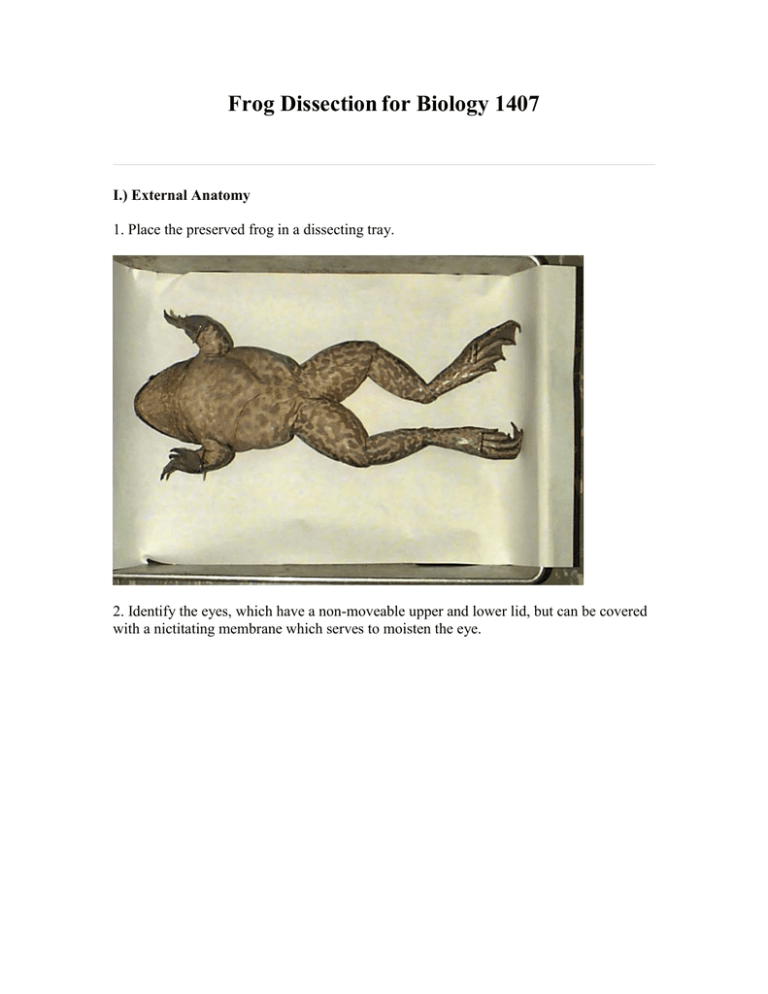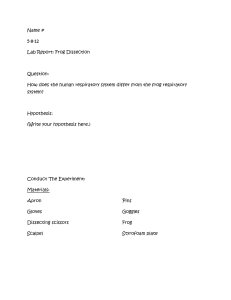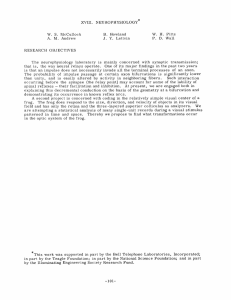Frog Dissection for Biology 1407
advertisement

Frog Dissection for Biology 1407 I.) External Anatomy 1. Place the preserved frog in a dissecting tray. 2. Identify the eyes, which have a non-moveable upper and lower lid, but can be covered with a nictitating membrane which serves to moisten the eye. 3. Locate the tympanum behind each eye. 4. Examine the external nares (nostrils). Insert a probe into the external nares and note that it protrudes from one of the paired small openings, the internal nares inside the mouth cavity. 5. Identify the paired appendages. The short forelimb consist of an upper arm (forearm) and a hand. The hand has four digits and a rudimentary vestigial thumb. The hind limb consists of a thigh, shank, and a foot. The foot has five digits and a rudimentary sixth digit. * Which pair of limbs is longest?_________________________________________ * How does a frog locomote on land?_____________________________________ * What is a frog’s means of locomotion in the water?_________________________ II.) Mouth Anatomy 1. Open your frog's mouth very wide, cutting the angles of the jaw if necessary. 2. Identify the tongue attached to the lower jaw's anterior end. 3. Find the Eustachian tube opening into the angle of the jaws. These tubes lead to the ears. Eustachian tubes equalize air pressure in the ears. 4. Examine the maxillary teeth located along the rim of the upper jaw. Another set of teeth, the vomerine teeth, is present just behind the mid portion of the upper jaw. 5. Locate the glottis, a slit through which air passes in and out of the trachea, the short tube from the glottis to the lungs. *What is the function of the glottis?__________________________________________________________________ 6. Identify the esophagus. which lies dorsal and posterior to the glottis and leads to the stomach. Setup for the Dissection Preparation: This section explains the steps necessary to prepare your frog for the dissection process. 1. Place Frog in Pan Rinse the frog with water then place it in the dissection pan. The frog should be lying on it's dorsal (back) side with the belly facing up. 2. Pin the Frog Pin the frog for dissection by securing each of the four limbs to the pan. Place the pins through the hands and feet to secure them to the pan. 3. Begin the First Skin Incision Once the legs of the frog are securely pinned to the dissection tray begin the first skin incision by using the forceps to lift the skin midway between the rear legs of the frog. Using the scalpel, make a cut along the center, or midline, of the frog, bisecting it equally. 4. Continue the Skin Incision Continue the skin incision by using the scissors to cut all the way up the frog's body to the neck. Be very careful not to cut too deeply. 5. Make the Leg Incisions Still using the scissors, make horizontal incisions just above the rear legs and between the front legs of the frog. 6. Separate the Skin & Muscle Once you have finished the incisions between the front and rear legs of the frog you need to separate the skin flaps from the muscle below. To do this: Pick up the flap of skin with the forceps, and Use a scalpel to help separate the skin from the muscle below. 7. Pin Skin Flaps Once the skin flaps have been cut pin them to the dissection tray using several pins. 8. Begin the First Muscle Incisions This section will describe the procedures for making the incisions through the frog's abdominal muscles. Now that the skin has been removed, begin the abdominal muscle incision by using the forceps to lift the muscle midwy between the rear legs of the frog. Next use the scalpel to start the incision in the direction of the chin. 9. Continue the Muscle Incision Using the scissors, carefully continue the incision up the midline of the frog, but do not cut too deeply as to damage the organs. 10. Turn Scissors Blades This is very important. When you reach a point just below the front legs, turn the scissors blades sideways to cut through the bones in the chest. This should prevent damage to the heart or other internal organs. When your scissors reach a point just below the frog's neck you have cut far enough. 11. Make the Second Muscle Incisions Next, using the scissors, make horizontal incisions through the muscle between both the front legs and above the back legs. 12. Separate Muscle & Organs To finish opening up the frog's body cavity therefore exposing the abdominal region, use the forceps to hold the muscle flaps while separating the muscle from the tissues below with a scalpel. 13. Pin the Muscle Flaps Once the muscle flaps have been separated from the underlying tissue, they must be pinned back. This will allow easy access to the frog's internal organs Respiratory System and Liver 1. Insert a probe into the glottis, and observe its passage into the trachea. Enlarge the glottis by making short cuts above and below it. When the glottis is spread open, you will see a fold on either side; these are the vocal cords used in croaking. 2. Identify the lungs, two small sacs on either side of the midline and partially hidden under the liver. Trace the path of air from the external nares to the lungs.___________________________________________________________________ ________________________________________________________________________ 3. Locate the liver, the large, prominent, dark-brown organ in the mid ventral portion of the trunk. 4. Under the liver, find the gallbladder. Circulatory System 1. Lift the liver gently. Identify the heart, covered by a membranous covering (the pericardium). With forceps, lift the covering, and gently slit it open. The heart consists of a single, thick-walled ventricle and two (right and left) anterior, thin-walled atria. 2. Locate the three large veins that join together beneath the heart to form the sinus venosus. (To lift the heart, you may have to snip the slender strand of tissue that connects the atria to the pericardium.) Blood from the sinus venosus enters the right atrium. The left atrium receives blood from the lungs. 3. Find the conus anteriosus, a single, wide arterial vessel leaving the ventricle and passing ventrally over the right atrium. Follow the conus anteriosus forward to where it divides into three branches on each side. The middle artery on each side is the systemic artery, which fuses behind the heart to become the dorsal aorta. The dorsal aorta transports blood through the body cavity and gives off many branches. The posterior vena cava begins between the two kidneys and returns blood to the sinus venosus. * Which vessel lies above the other?______________________________________________ Digestive System 1. Identify the esophagus, a very short connection between the mouth and the stomach. Lift the left liver lobe, and identify the stomach, which is whitish and J-shaped. The stomach connects with the esophagus anteriorly and with the small intestine posteriorly. * With a pin identify/label the stomach. Make a small insision and examine the contents of the stomach._________________________________________________________ 2. Find the small intestine and the large intestine, which enters the cloaca. The cloaca lies beneath the pubic bone and is a general receptacle for the intestine, the reproductive system, and the urinary system. It opens to the outside by way of the anus. Trace the path of food in the digestive tract from the mouth to the cloaca. * With a pin identify/label the small and large intestine._____________________________________________ 3. As you lift the small intestine you will see the pancreas, a thin, yellowish ribbon, between the small intestine and the stomach. 4. Locate the fat bodies near the stomach. * Label/identify with a pin._______________ VII.) Urogential System The urogenital system consists of both the urinary system and the reproductive system. 1. Identify the kidneys, which are long narrow organs lying against the dorsal wall. * Place a pin to locate the kidneys.____________________________________________ 2. Identify the urinary bladder, attached to the ventral wall of the cloaca. In frogs, urine backs up into the bladder from the cloaca. * The cloaca receives material from (1)_____________ (2)______________________ and (3)_______________________. Male Anatomy 1. Locate the testes in the male frog. They are yellow or tan-colored, bean-shaped organs near the anterior end of each kidney. Several small ducts, the vasa efferential, carry sperm into the kidney ducts that also carry urine from the kidneys. Fat bodies, which store fat, are attached to the testes. Female Anatomy 1. Locate the ovaries in the female frog. They are attached to the dorsal body wall. Fat bodies are attached to the ovaries. Highly coiled oviducts lead to the cloaca. The ostium (opening) of the oviducts is dorsal to the liver. Cleanup 1. Dispose of all frog parts properly in the container marked Animal Waste. Do not leave any of parts in the trash cans or sink. 2. Rinse and dry all equipment used, including the dissecting pan.






